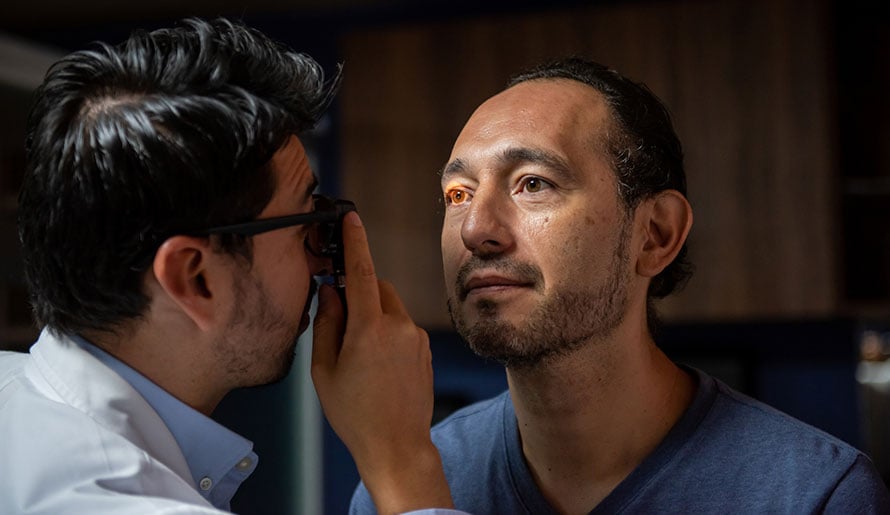Neurofibromatosis Overview

Neurofibromatosis is a genetic condition that affects the development of nerve cells, causing small tumors to form on the brain, spinal cord and other nerve tissues. The tumors are almost always benign (noncancerous), although certain types have the potential to progress into malignant peripheral nerve sheath tumors.
Neurofibromatosis causes
Neurofibromatosis is caused by a genetic mutation that can be inherited from a parent. The mutation can also occur spontaneously. The specific genes involved can vary depending on the type of neurofibromatosis, such as:
- Neurofibromatosis type 1 (NF1) – Results from a mutation in the NF1 gene on chromosome 17, which produces a protein (neurofibromin) that helps regulate cell growth. The mutated gene causes a loss of neurofibromin, leading to uncontrolled cell growth.
- Neurofibromatosis type 2 (NF2) – Results from a mutation in the NF2 gene on chromosome 22, which produces a protein (merlin) that suppresses tumors. The mutated gene causes a loss of merlin, leading to uncontrolled cell growth.
- Schwannomatosis – Results from a mutation in the SMARCB1 or LZTR1 gene, both of which suppress tumors.
Neurofibromatosis risk factors
The primary risk factor for neurofibromatosis is a family history, which increases the likelihood of inheriting a mutation in the NF1 or NF2 gene. Both NF1 and NF2 are inherited in an autosomal dominant pattern, which means that only one copy of the mutated gene is needed to develop the condition. The inheritance pattern for schwannomatosis is unclear.
Other risk factors for neurofibromatosis may include advanced paternal age and certain environmental factors, which are not yet well understood. Close monitoring and genetic counseling are recommended for individuals with a family history of neurofibromatosis or those who are concerned about their risk.
Neurofibromatosis symptoms
The symptoms of neurofibromatosis can vary depending on the type:
NF1
The signs of NF1 are often noticeable at birth or shortly thereafter, and almost always by age 10. These include:
- More than six café au lait spots, which are harmless pigmented birthmarks that look like flat, light brown spots on the skin
- Clusters of freckles that appear in the armpits or groin area before age 5
- Tiny bumps on the iris of the eye (Lisch nodules), which are not easily seen and do not affect vision
- Tumors on the optic nerve (optic gliomas)
- Soft, pea-sized bumps on or underneath the skin (neurofibromas)
- Bone deformities, such as a curved spine (scoliosis) or a bowed lower leg
- Learning disabilities, such as attention-deficit/hyperactivity disorder (ADHD), speech delay or problems with reading or mathematics
- A large head size due to increased brain volume
- Short stature

NF2
The symptoms of NF2 usually result from the development of acoustic neuromas. These benign, slow-growing tumors form on the nerve that carries sound and balance information from the inner ear to the brain. In addition to gradual hearing loss, acoustic neuromas can cause:
- Ringing in the ears
- Impaired balance
- Headaches
NF2 can also cause tumors to form on other nerves, such as the cranial, spinal, visual (optic) and peripheral nerves. The symptoms can include:
- Numbness or weakness in the arms or legs
- Vision problems or cataracts
- Facial drop
- Seizures
Schwannomatosis
A rare type of neurofibromatosis, schwannomatosis causes tumors to develop on the cranial, spinal and peripheral nerves. Because the tumors rarely form on the hearing nerves, schwannomatosis usually does not cause hearing loss. The symptoms, which typically become noticeable between ages 25 and 30, can include:
- Chronic pain
- Numbness or weakness
- Loss of muscle mass
Neurofibromatosis diagnostic testing
If neurofibromatosis is suspected, a physician will typically begin the diagnostic process with a personal and family medical history review and a physical examination. During the exam, the physician will check the patient’s skin for café au lait spots, a characteristic symptom of NF1.
If additional testing is needed to confirm the diagnosis, the physician may order:
- An eye exam to check for impaired vision, cataracts and Lisch nodules
- Audiometry to check for hearing loss
- Electronystagmography, which can detect balance problems by using electrodes to record eye movements
- Imaging tests, such as X-rays, computed tomography (CT) scans or magnetic resonance imaging (MRI) scans to check for bone abnormalities and brain and spinal cord tumors
- Genetic testing to check for mutations in the NF1 and NF2 genes
Neurofibromatosis treatment
Because there is currently no cure for neurofibromatosis, treatment generally focuses on managing the symptoms and preventing complications. This may include:
- Surgical removal of the tumors and affected tissues, particularly if they are causing discomfort or functional impairment
- Medications to manage pain, seizures or high blood pressure
- Physical or occupational therapy to improve mobility and function
- Speech therapy to improve communication skills
Most patients are regularly monitored and screened for potential complications, such as vision and hearing loss, cardiovascular problems and tumor progression. Genetic counseling and support services may also be offered to provide education, guidance and emotional support.
Frequently asked questions (FAQs) about neurofibromatosis
The following FAQs-related articles provide additional information about neurofibromatosis:
- How do I prepare for neurofibromatosis treatment?
- Am I at risk for developing neurofibromatosis?
- How does neurofibromatosis affect the body?
Benefit from world-class care at Moffitt Cancer Center
The multispecialty team in Moffitt’s Neuro-Oncology Program takes a highly individualized approach to neurofibromatosis treatment. Our surgical oncologists and neurosurgeons use advanced, minimally invasive techniques to remove difficult-to-access tumors with a high level of precision. Our medical oncologists and radiation oncologists design customized chemotherapy and radiation therapy regimens using the latest chemo drugs and radiation delivery techniques. Working in tandem with our physicians, our supportive care specialists provide medications and other therapies to help each patient achieve the best possible outcome and quality of life. Our team also works closely with our young patients’ parents, teachers, psychologists and other key professionals to develop personalized action plans.
To learn more about neurofibromatosis, you can request an appointment with a specialist at Moffitt by calling 1-888-663-3488 or submitting a new patient registration form online. We do not require referrals.
